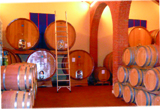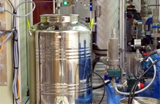Biogenic materials such as food must be stabilized for storage or transport by inactivating the microbiological contamination


Established methods for preserving foods, such as heat sterilization or pasteurization, often have the disadvantage of destroying valuable heat-sensitive food ingredients such as vitamins, thus reducing their nutritional value. The addition of chemical preservatives can also have a negative impact on product quality and thus on the consumer. In addition, EU directives (2003/89/EC) regarding the addition of excipients with a potential allergy risk (e.g. sulfur dioxide) in food products are becoming increasingly stringent, as is their use in non-alcoholic and alcoholic beverages. Alternatives to sterilization are therefore in demand.
Sterilization with physical processes
The development of new processes for biological stabilization or sterilization and thus for the preservation of foods, cosmetics and pharmaceuticals is a research focus at Fraunhofer IGB. Physical or chemical-physical processes for the inactivation of contaminating microorganisms, such as the pressure swing technique, are primarily being investigated.
One focus is on inactivation mechanisms of processes as well as understanding and describing the interaction of the different parameters in the system (temperature, pressure, particle size, viscosity, pH, etc.) in order to optimize the processes technologically and to be able to implement them in a production process. Emphasis is placed on treating the ingredients of the products as gently as possible and ensuring that their biological function is not impaired during treatment.
Pressure change technology
Pressure change technology (PCT) is a non-thermal process for treating liquids with suspended particles. The product is mixed with an inert gas under pressure and then abruptly depressurized. Cell disruption of microorganisms or mechanical damage to the surface of, for example, spores or enzymes occurs.
The process is preferably applied between 5 °C and 40 °C at pressures up to about 50 MPa. The liquid or suspension to be treated and the working gas (e.g. argon or nitrogen) are each placed under working pressure and then mixed homogeneously. In the case of microorganisms with cell membranes, the gas diffuses transmembrane into the cells until the cytoplasm is saturated with gas. When the mixture is then abruptly depressurized to a lower pressure level, the gas just as abruptly returns to its original aggregate state. This destroys the cells. However, cavitative effects also cause damage to particle surfaces, for example erosion of spores.
Preservation of wine
For the preservation of liquid foods such as fruit juices or wine, the pressure swing technology was further developed into a continuous process and the effect of the process parameters on various products was investigated.
In the EU-funded PreserveWine project, pressure swing technology is being investigated as an alternative to the addition of the preservative sulfur dioxide in various process steps of wine production. The objectives of the project are both the inactivation of microorganisms after alcoholic and malolactic fermentation and the protection of wine against oxidation by an inert atmosphere. A batch plant was built for initial tests with wine.
Currently, the process is being validated with wine in cooperation with the Institut des Sciences de la Vigne et du Vin in Bordeaux. Various parameters such as temperature, retention time and gas type and the effect on wine-relevant yeasts (e.g. Saccharomyces cerevisiae) and bacteria (e.g. Lactobacillus sp.), as well as physicochemical and sensory properties of the product, are being investigated.
A continuous plant for the specific requirement of wine producers has been designed and is currently being built. The process will then be optimized for wine production application in further trials and validated with red and white wines from users in Italy and France.
As part of the activities, the entire process from product development, processing and stabilization to plant engineering is being analyzed and validated, taking into account common GMP (Good Manufacturing Practice) standards and risk analysis procedures such as HACCP (Hazard Analysis and Critical Control Points).
 Fraunhofer Agriculture and Food Industry Alliance
Fraunhofer Agriculture and Food Industry Alliance